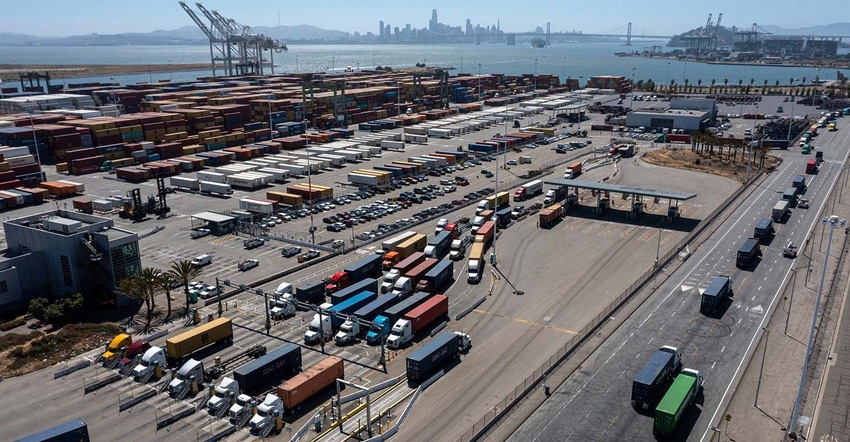
By Kim Chipman and Augusta
As summer winds down and the holiday season nears, California’s $1 billion walnut industry is gearing up for its busiest shipping season. The problem is getting nuts out the door.
Farmers started the new marketing year Thursday with a massive backlog of product as they prepare to harvest what could be a bumper crop. The state, which grows about 30% of the world’s walnuts, makes up nearly all U.S. production.
The dilemma stems from supply-chain bottlenecks that have cut into both foreign and domestic shipments, costing California producers an estimated $1.3 billion in lost wholesale value this year alone. The logistical woes, including massive container ship congestion at California’s Port of Oakland, risk handing export rivals like Chile and China a competitive edge. The industry also has had to contend with angry customers and plummeting prices.
“It’s a classic supply issue,” said Don Barton, president of GoldRiver Orchards, a walnut grower and processor in the Central Valley, a region that produces 40% of America’s nuts and fruits.
Bypassing the port
The risk of more logjams has prompted Barton to try something new: send product by rail from California to Virginia, where nuts are then loaded on ships for destinations like Europe and Israel.
“The cost is higher but we have to do what we have to do to get our crop moving,” Barton said.
The “mess” at the Oakland port, as well as a strong dollar denting the global appeal of goods priced in the U.S. currency, are among the reasons for the glut, according to Barton. Wholesale export prices for Chandler walnuts -- the leading variety grown in California -- have plunged to 80 cents a pound from $1.25 a year ago, he said.
California is the biggest global shipper of walnuts and the second-largest grower after China. A third of the U.S. crop is consumed domestically and the rest is exported, with top importers including Germany, Turkey, Japan and South Korea. The shipping snarls began taking a big toll last year, adding to a raft of pressures.
“Between trade wars, COVID and port issues, the industry has lost $3 billion over the last five years when you put it all together,” said Pamela Graviet, who serves as senior international marketing director for the California Walnut Commission.
Walnuts, the oldest tree food known to humans and prized for their healthy omega-3 fatty acids, have a shelf life of around 12 to 18 months, depending on how the nuts are stored. That makes them harder to stockpile than nuts like almonds, which can stay good for more than two years.
Container ship delays have meant some product sitting in hot vessels for extended periods and going bad before reaching customers. The top use for walnuts that are past their prime is bird food, Graviet said.
US producers soon will head into their busiest exporting period as walnut demand revs up around worldwide holidays like Diwali, Christmas and Ramadan. The shipping snarls last season led to 70,000 tons worth of lost walnut sales, or about 10% of the crop, according to Graviet.
“Walnuts are a part of all of those holiday traditions,” she said. “With the inability to get our product out we missed those windows.”
It’s not just walnuts. Almonds — California’s second highest-valued agriculture commodity after dairy — and other farm products have been hit hard by congested shipping routes. Walnut exporters and other agriculture shippers in the state are in talks with top steamship and rail carriers for a new trade pathway to bypass Oakland and get their products overseas faster.
"We've got more than 2 billion pounds of almonds sitting in warehouses because they cannot get to their markets overseas," said Gene Seroka, executive director for the Port of Los Angeles, the largest U.S. trade gateway. Agricultural exports out of southern California have been falling for at least three years now, he noted.
The busiest port in California after Los Angeles and Long Beach, Oakland has faced issues ranging from capacity to labor during the pandemic. In July, the hub shut down for almost a week after truckers protesting a gig-work law that could take 70,000 California drivers off the road blocked access to the operation.
California's walnut output this year is forecast at 720,000 tons, down 1% from 2021, according to an updated estimate Thursday from the U.S. Department of Agriculture. If realized, the crop would be the state's third-biggest since at least 2003. Farmers initially benefited from heavy precipitation late last year but then orchards were hindered by hot and dry conditions amid the worst drought in 1,200 years.
Barton is among farmers across the Central Valley who has had his surface water allocation curtailed. While his walnut trees have managed with adequate groundwater, he's concerned about the industry outlook next year if the state doesn't get some desperately needed rain and snow.
The water restrictions are a "shot over the bow about what’s coming if this drought is not broken,” he said.
© 2022 Bloomberg L.P.
About the Author(s)
You May Also Like




